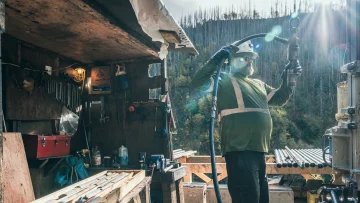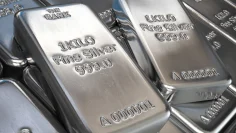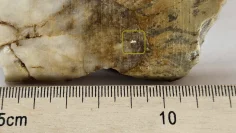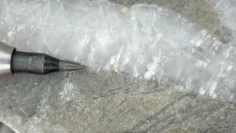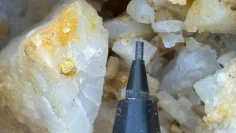Industrial demand for silver cannot be met
Silver is a scarcer commodity than many of our contemporaries currently believe. Admittedly, as a precious metal, silver has always been rarer than other metals and therefore more valuable, but does that mean it should be scarce? Unfortunately, the past is not a template for the future at this point, because today there are no longer the full stocks that could be drawn on when needed in the past.
For some years now, demand for silver has outstripped production and the silver market has been in deficit for four years in a row. Until 2016, silver production grew from year to year and peaked at 900.1 million ounces or 27,996 tons. At that time, the price of silver was USD 13.30 per ounce.
Although silver has become noticeably more expensive since then, this price increase has had no effect on mine production. This has continued to decline, meaning that mine supply for 2024 is expected to be 62.8 million ounces or 1,954 tons below the 2016 peak. This corresponds to a decline of seven percent.
Empty warehouses cannot permanently cover the increasing demand
The lack of silver has so far been compensated for by drawing on existing above-ground deposits. These warehouses still exist today, of course, but they no longer contain the silver needed to cover the gap between supply and demand.
A loud, unmistakable wake-up call should therefore be sounding not only for the mining industry, but also for the industry in general. It should lead to more silver being mined and, at the same time, a massive increase in efforts to recycle more silver.
The supply from the mines, which should now actually be increasing, is falling, meaning that the still growing demand can only be met by the existing stockpiles. The falling mine production is due to declining ore yields. In the last ten years alone, the silver content of the ore has fallen by 22% on average.
The wake-up call has long been sounded, but an appropriate response has so far been sought in vain
What is not helpful in this situation is that many silver producers do not feel the need to ramp up their production even if the silver price rises sharply. This curious observation is due to the fact that around 72% of the silver mined worldwide is only mined as a by-product.
In other words, the majority of producers do not pay attention to the price of silver, but only to the price of their respective main product, such as gold, lead or zinc. The price of silver could explode in this context, but as long as the prices for lead and zinc do not also rise sharply, none of these producers will think of increasing their own mine production.
The situation for the pure silver mines is also anything but rosy. The last decade has been tough. Many companies only generated small profits or even made losses. Savings were therefore made wherever possible, particularly in exploration and investment. However, both aspects are essential if new silver projects are to be developed and brought into production.
Recycled silver could be the solution, but it is not
A well-developed recycling system could save the situation. This still existed in the 1990s, when a large proportion of the silver to be recovered came from analog photography. Today, however, only between 20 and 25 percent of the silver processed is recovered through recycling processes. By comparison, this proportion is 80 to 90 percent for the much more expensive gold.
At current prices, it makes no sense to recycle silver. The costs are higher than the expected profits. As long as this remains the case, it is to be expected that the proportion of recycled silver will remain very small and therefore cannot help to ease the situation in the short term.
One of the big unknowns in this game is China. The People’s Republic is the second largest silver producer in the world after Mexico. At the same time, large quantities of silver concentrate are transported from Latin America to China and processed there. So far so bad, because the Chinese leadership recently decided to restrict the export of silver.
The courts also affect silver production
The mines are also struggling with other problems, some of which are of their own making. For example, the Escobal mine in Guatemala still produced 21 million ounces of silver in 2016. That corresponds to 653 tons. Today, this mine no longer produces silver, as mining was banned by court order in 2017 until further notice. A year later, the Constitutional Court in Guatemala confirmed the closure on the grounds that the legally required consultation with the local indigenous community had been omitted.
The court-ordered consultation process with the Xinka people is now underway. But no one can say when and how it will end. In a similar case in Panama, the Supreme Court ruled in 2023 that the operation of First Quantum’s Cobre Panama mine was unconstitutional. Although First Quantum’s main product at the mine was copper, the impact on silver production was enormous, as once again 2.8 million ounces or 87 tons of silver were withdrawn from the market from one day to the next.
The silver market is therefore much more fragile than many investors currently expect. The longer the high demand lasts and the emptier the warehouses become, the tougher the battle for silver is likely to become. In such a scenario, the price is unlikely to remain at today’s level.
Disclaimer: GOLDINVEST Consulting GmbH offers editors, agencies and companies the opportunity to publish comments, analyses and news on https://www.goldinvest.de. This content is intended solely for the information of readers and does not represent any kind of call to action; neither explicitly nor implicitly are they to be understood as a guarantee of any price developments. Furthermore, they are in no way a substitute for individual expert investment advice; rather, they are advertising/journalistic publications. Readers who make investment decisions or carry out transactions on the basis of the information provided here do so entirely at their own risk. The acquisition of securities, especially in the case of penny stocks, involves high risks that can lead to the total loss of the capital invested. GOLDINVEST Consulting GmbH and its authors expressly exclude any liability for financial losses or the guarantee that the content of the articles offered here is up-to-date, correct, appropriate and complete. Please also note our terms of use.
In accordance with §34b WpHG (Securities Trading Act) and Section 48f (5) BörseG (Austrian Stock Exchange Act), we would like to point out that clients, partners, authors and employees of GOLDINVEST Consulting GmbH hold or may hold shares in Golden Carbiboo Resources and therefore a possible conflict of interest exists. Furthermore, we cannot rule out the possibility that other market letters, media or research companies may discuss the stocks we recommend during the same period. This may result in the symmetrical generation of information and opinions during this period. Furthermore, there is a consulting or other service agreement between Golden Carbiboo Resources and GOLDINVEST Consulting GmbH, which constitutes a conflict of interest.




